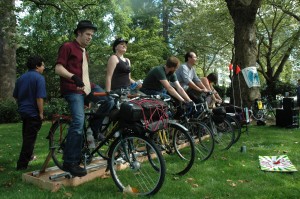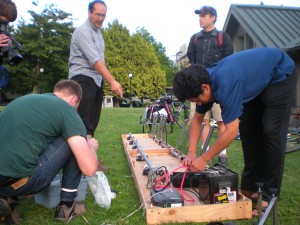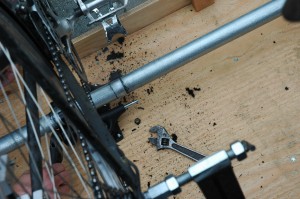My first human power project, the Seattle Bicycle Music Festival in 2010, was an amazing success. This, in large part, is why I want I’m so excited to put on another show! We built our own generator, inspired by Rock The Bike‘s Biker Bar (which has since been discontinued for reasons I will discuss later). Like the Biker Bar, our generator used a single generator coupled to the bikes by a long tire driven shaft. Like the Biker Bar, our generator folded in half to become an 8 foot long trailer. Unlike the Biker Bar, however, our shaft folded too, allowing us to squeeze five bikes onto the contraption, instead of three! A 90amp VW Bus alternator, with it’s own voltage regulation circuitry built in, converted those pedaler’s work to clean 12V, variable current DC. The volunteer cyclists were able to power all the acts, including quite a loud rock band who brought along three tube amplifiers! We had our share problems though, and I learned a great deal.
The bikes should be on display

One of the best parts of the bike powered concert is that the folks powering the concert are right next to the band, facing the audience. They’re on display. The audience knows that this is part of they act, and it’s their turn next! With a system like this, the volunteers are close enough to have a conversation with each-other. This, I think, kept people coming back to the bikes more than anything else.
Mechanical transmission is lossy

for all it’s simplicity, The common-shaft approach has a major downfall in the form of mechanical losses; the tires contacting the shaft, the support bearings, the flexible shaft couplers, all of these are big energy sinks, which is why Rock the Bike has stopped building their Biker Bar system, and why Movable Parts is using a different system.
Don’t skimp on critical components!
We made the mistake of taking our shaft bearings from the cheapest skateboards we could find ($25 apiece). Within an hour of use, the loose ball bearings inside had burned up all their lubrication and had moved on to burning up the polyurethane wheels:

The wheels rapidly conformed to the shape of the shaft and stopped spinning, polishing the shaft nicely and sprinkling shredded polyurethane all over the generator floor:

The above photographer was sent on a mission to a nearby skateshop (which kindly opened an hour early) for 20 high quality skateboard wheels and bearings (which cost about as much as five complete $25 skateboards), and the show went on.

 Home
Home
4 Comments
Pingback: Movable Parts » Rear Wheel Tachometer
Pingback: Movable Parts » Redirecting the Flow of Power
Pingback: beingwendyhsu.info » Redirecting the Flow of Power
Pingback: Rear Wheel Tachometer using arduino -Use Arduino for Projects